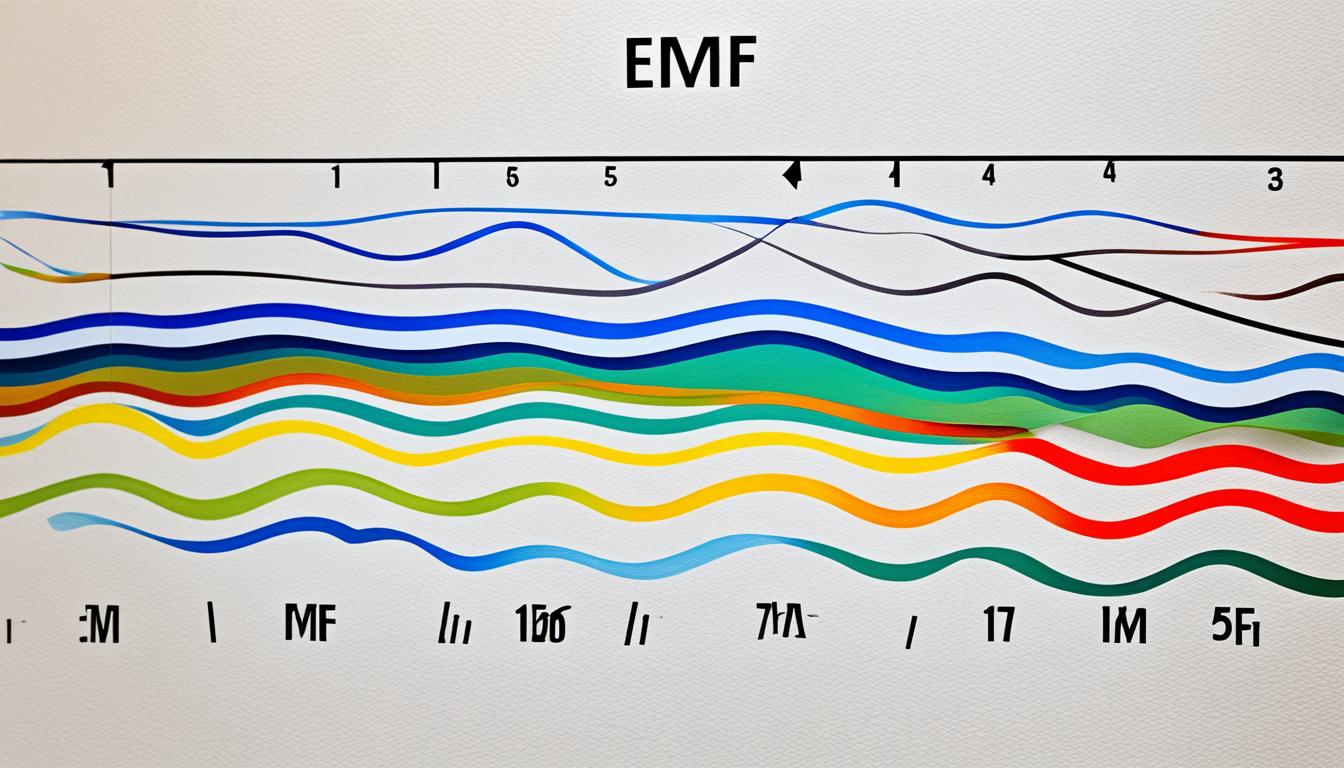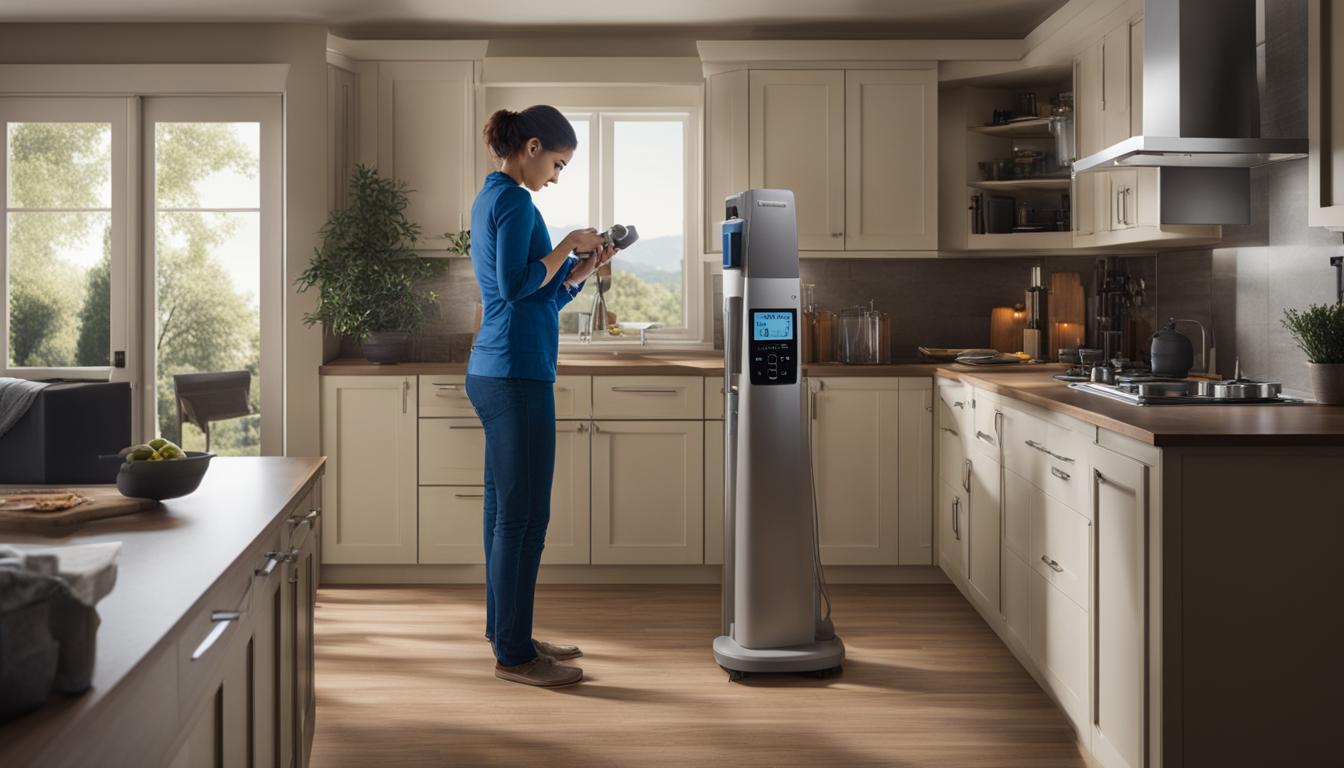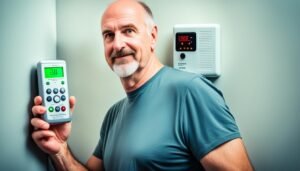Disclosure: This Post Contains Affiliate Links; We earn a commission on purchases.
Welcome to our comprehensive guide on measuring electromagnetic fields (EMFs) in your environment. In today’s technology-driven world, EMFs are all around us, and understanding their levels is crucial for maintaining a healthy living space. Whether you’re concerned about non-ionizing radiation from everyday devices or want to assess your exposure to ionizing radiation, this guide will provide you with the knowledge and tools to measure EMFs effectively.
In this guide, we will explore the different types and sources of EMFs, delve into the potential health concerns surrounding EMF exposure, discuss how to measure EMFs at home using reliable devices, and provide tips on reducing your exposure to EMFs. By the end, you will be equipped with the information you need to make informed decisions and create a safer environment for yourself and your loved ones.
Key Takeaways:
- EMFs are areas of energy associated with electrical power and lighting.
- Non-ionizing radiation, such as ELF and RF radiation, is generally considered harmless to humans.
- Ionizing radiation, such as UV, X-rays, and gamma rays, has the potential for cellular and DNA damage.
- No strong scientific evidence links EMF exposure to adult cancers, but more research is needed.
- The CORNET ED88TPLUS is a recommended device for measuring EMFs at home.
Understanding EMF Types and Sources
When it comes to electromagnetic fields (EMFs), it’s important to understand the different types of radiation and the sources from which they originate. EMFs can be categorized into non-ionizing radiation and ionizing radiation, each with distinct characteristics and sources.
Non-Ionizing Radiation
Non-ionizing radiation refers to low to mid-frequency EMFs that are generally considered harmless to humans. This type of radiation includes extremely low frequency (ELF), radio frequency (RF), microwaves, and visual light. Non-ionizing radiation is emitted by a variety of everyday devices and objects, including:
- Household appliances
- Wireless networks
- Cell phones
- Power lines
These sources of non-ionizing radiation are commonly found in homes and public spaces, and their levels can vary depending on the proximity to the source.
Ionizing Radiation
Ionizing radiation, on the other hand, consists of higher frequency radiation that has the potential for cellular and DNA damage. This type of radiation includes ultraviolet (UV) radiation, X-rays, and gamma rays. Ionizing radiation can be emitted by various sources, including:
- The sun
- X-ray machines
- Certain medical devices
Unlike non-ionizing radiation, ionizing radiation poses greater risks and is often associated with medical procedures or natural sources such as the sun.
It’s important to note that the strength of a magnetic field decreases as the distance from the source increases. This means that the levels of EMFs reaching a house or structure will be significantly weaker than at the point of origin. Understanding the types and sources of EMFs is the first step in effectively measuring and minimizing exposure to these fields.
Health Concerns and EMF Exposure
Despite ongoing concerns about the potential health effects of EMF exposure in today’s era of cellular telephones and wireless technology, scientific evidence has not definitively linked EMF exposure to adverse health problems in humans. Extensive studies conducted on adults have failed to establish evidence of a direct correlation between EMF exposure and adult cancers, including leukemia, brain cancer, and breast cancer. However, it is important to note that further research is necessary to gain a comprehensive understanding of the potential long-term health effects associated with EMF exposure.
One area of focus is cell phone radiation, particularly radio frequency (RF) radiation. Cell phones emit RF radiation at the lower end of the non-ionizing radiation spectrum. However, current scientific evidence does not establish a conclusive link between cell phone use and adverse health problems. Nevertheless, ongoing research is essential to monitor and investigate any potential health risks associated with cell phone radiation and other forms of EMF exposure.
“Scientific evidence has not definitively linked EMF exposure to adverse health problems in humans.”
Monitoring and remaining informed about the latest scientific research on EMF exposure is vital for individuals concerned about their well-being. While there is no substantial evidence of immediate health risks, it is always prudent to exercise caution and adopt best practices to minimize unnecessary exposure.
Key Takeaways:
- Scientific studies have not conclusively linked EMF exposure to adverse health effects in humans.
- Research has not found evidence of a direct correlation between EMF exposure and adult cancers, such as leukemia, brain cancer, and breast cancer.
- Current scientific evidence does not establish a conclusive link between cell phone use and adverse health problems.
- Continued research is necessary to gain a better understanding of the potential long-term health effects associated with EMF exposure.
| Common Concerns | Scientific Evidence |
|---|---|
| Link between EMF exposure and adult cancers | Scientific studies have not provided conclusive evidence of a direct correlation. |
| Potential health risks from cell phone radiation | Current scientific evidence does not establish a conclusive link. |
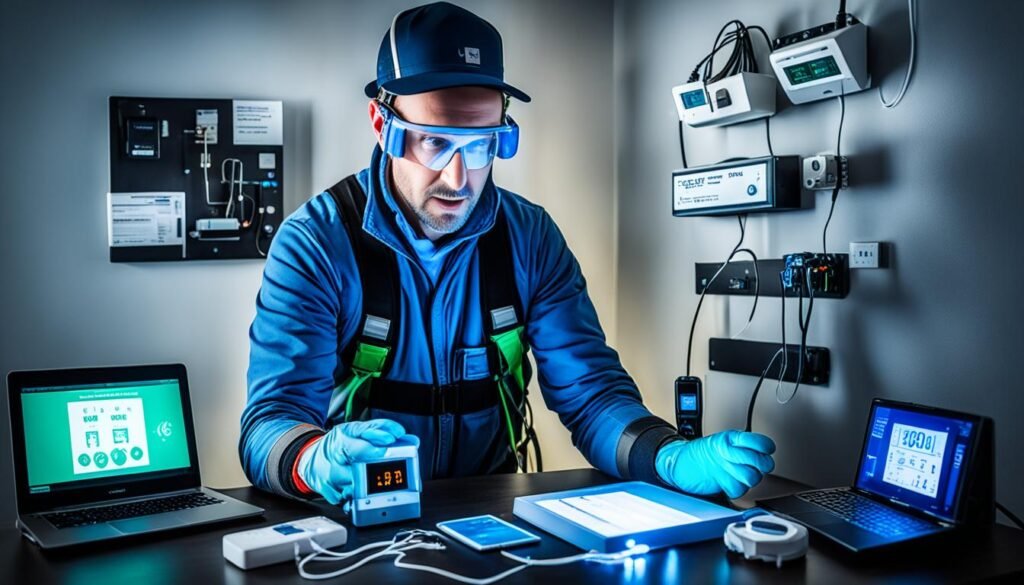
Measuring EMFs at Home
When it comes to safeguarding your home from electromagnetic fields (EMFs), it’s crucial to measure and understand the levels of exposure. The first step in this process is to obtain a reliable EMF meter. One widely recommended device is the CORNET ED88TPLUS, which is capable of measuring both radio frequency (RF) and extremely low-frequency (ELF) fields.
Once you have your EMF meter, take the time to familiarize yourself with its operation and the different modes it offers. Understanding the display and its indications will ensure accurate measurements and comprehensive insights.
When measuring RF radiation, it’s advisable to capture radiation levels along all three axes (X, Y, Z) to obtain a comprehensive overview. Make note of the maximum value and peak average to assess any potential risks effectively. Furthermore, correctly holding the meter during measurements is vital to ensure precision and reliability.
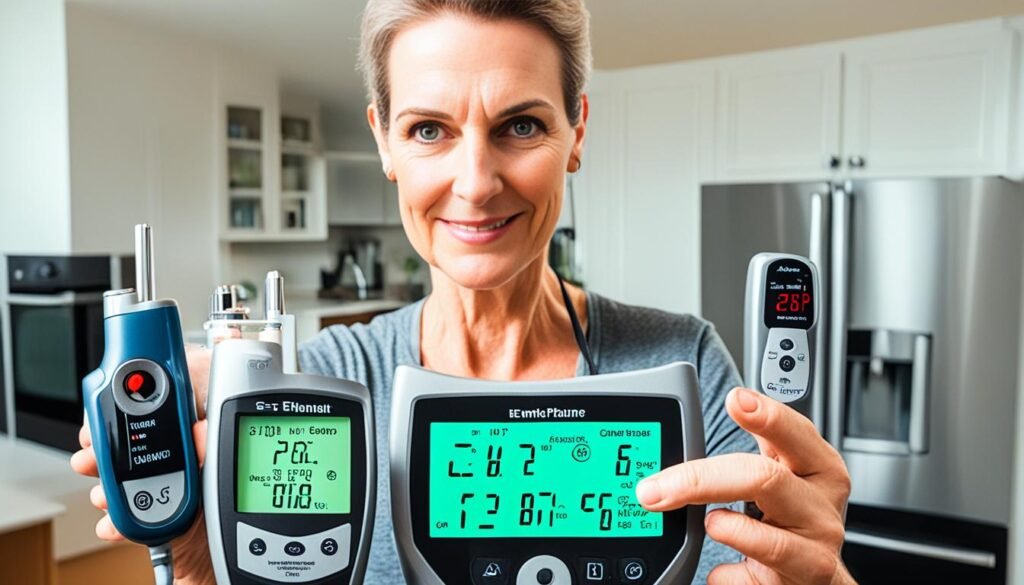
“To protect yourself and your loved ones, it’s important to be equipped with an EMF meter and know how to use it effectively. This empowers you to make informed decisions regarding your exposure and take appropriate measures to reduce any potential risks.”
Assessing EMF Levels and Exposure Reduction
Once you have obtained an EMF meter and learned how to use it, you can start assessing EMF levels in different areas of your home. It is recommended to focus on areas where people spend a significant amount of time, such as bedrooms and sitting/working areas. By measuring RF and ELF fields in these areas, you can identify any sources of high levels of EMF.
“Measuring EMF levels is a crucial step in understanding the potential health impact of electromagnetic fields. By identifying areas with elevated EMF levels, we can take necessary steps to reduce exposure and create a safer living environment.”
If you encounter high levels of EMF during assessments, try unplugging devices and appliances to see if the levels decrease. This can help identify specific sources of EMF emissions and determine whether they are contributing to the overall exposure levels in your home.
It is also important to conduct measurements at different times and on different days to get a clearer picture of your EMF exposure. EMF levels can vary throughout the day and may be influenced by factors such as nearby cell towers or electrical usage patterns in your home.
If you find elevated levels of EMF during your assessments and want to reduce your exposure, there are several techniques you can consider:
- Maintaining a safe distance from ELF sources: Move furniture or beds away from sources of high electromagnetic fields, such as power lines, electrical panels, or appliances.
- Using RF protection for the house: Install shielding materials, such as EMF-blocking paint or window films, to reduce the penetration of RF radiation into your home.
- Limiting wireless device usage: Minimize the use of wireless devices, such as cell phones, laptops, and tablets, especially in close proximity to your body.
By implementing these EMF reduction techniques, you can create a healthier and safer environment for yourself and your loved ones, minimizing the potential health risks associated with prolonged EMF exposure.
EMF Penetration Points and Protection
When it comes to protecting yourself and your home from EMF radiation, it’s crucial to identify the areas where these fields can penetrate. By understanding the EMF penetration points, you can take steps to minimize your exposure and create a safer living environment.
Identifying EMF Penetration Points
One of the first steps in protecting your home is to scan it for potential EMF penetration points. These points can include walls, windows, and any other areas where external EMF sources can enter your living space.
To determine if RF radiation is entering your home through these points, you can use an EMF meter by measuring the radiation levels against these surfaces. This will give you valuable insights into the extent of RF radiation penetration and help you identify areas that require additional protection.
Implementing RF Protection Measures
If you discover penetration points from external sources, it is essential to implement RF protection measures to reduce your exposure. There are various options available to shield your home from RF radiation, including:
- Shielding materials: These materials are designed to block or reduce the amount of RF radiation that enters your home through windows, walls, or other penetration points. They can be applied directly to these surfaces to create a barrier.
- Window films: Window films with RF shielding properties can be installed to protect against RF radiation from outside sources. These films are transparent and allow natural light to enter while reducing the penetration of RF radiation.
By using these RF protection measures, you can create a safer indoor environment and minimize your exposure to RF radiation.
Understanding ELF Radiation Penetration
While RF protection measures can address external sources of EMF radiation, protecting against extremely low-frequency (ELF) radiation penetration may require professional assistance. ELF radiation can emanate from sources such as power lines or electrical systems, and its penetration can vary depending on the materials in your home.
| ELF Protection Options | Benefits |
|---|---|
| Electromagnetic shielding | Blocks or reduces the penetration of ELF radiation |
| Electromagnetic field mitigation | Reduces or eliminates ELF radiation emitted from sources within your home |
It’s important to note that addressing ELF radiation penetration may require specialized knowledge and professional assistance. Consider consulting with experts with experience in EMF protection to determine the best course of action for your specific situation.
Implementing Recommended Safety Distances
In addition to addressing penetration points, it’s crucial to follow recommended safety distances from ELF sources to minimize your exposure. Keep a safe distance from electrical appliances, power lines, and other known sources of ELF radiation.
By understanding EMF penetration points and implementing appropriate protection measures, you can reduce your exposure to RF and ELF radiation, creating a safer living environment for you and your loved ones.
Monitoring and Redoing Measurements
Monitoring EMF levels in your home is an ongoing process. It is essential to periodically redo measurements to ensure the safety and well-being of you and your loved ones. This is especially important in areas where people spend a significant amount of time, such as bedrooms and living rooms.
By re-evaluating EMF levels, you can identify any changes that might occur over time and take appropriate actions to maintain exposure within recommended limits. This proactive approach helps create a safe and healthy living environment.
To effectively monitor EMF levels, it is recommended to keep a record of measurements in an Excel sheet. Note the testing points, date, and time of each measurement to maintain a comprehensive log.
Repeat measurements at different times and on different days to capture variations in EMF levels. Environmental factors, usage patterns, and even nearby sources can affect EMF levels. By conducting periodic measurements, you can gain a better understanding of potential fluctuations and ensure consistent monitoring over time.
Here is an example of how you can structure your measurement record:
| Testing Point | Date | Time | EMF Level (mG) |
|---|---|---|---|
| Bedroom | 2022-01-01 | 10:00 AM | 1.5 |
| Living Room | 2022-01-02 | 6:00 PM | 2.2 |
| Kitchen | 2022-01-03 | 8:00 AM | 0.8 |
By maintaining a comprehensive log, you can identify any persistent high levels of EMFs and investigate potential sources or areas that might require additional attention.
Remember, regularly monitoring and redoing measurements is crucial in maintaining a safe and healthy environment. By staying proactive and vigilant, you can ensure that your exposure to EMFs remains within recommended limits.
Conclusion
Measuring and monitoring electromagnetic fields (EMFs) in your environment is crucial for understanding and reducing your exposure to these fields. By following the best practices for EMF measurement outlined in this guide, you can gain valuable insights into the EMF levels in your home and take appropriate measures to reduce exposure if necessary.
First and foremost, it is important to use a reliable EMF meter, such as the CORNET ED88TPLUS, and ensure that you understand how to operate it correctly. Consistent measurements over time will provide a more accurate picture of the EMF levels in your surroundings.
Additionally, maintaining a safe distance from EMF sources is a key factor in reducing exposure. Pay attention to areas where you and your family spend a significant amount of time, such as bedrooms and sitting/working areas, and measure the RF and ELF fields in these locations. If high levels are detected, consider unplugging devices and appliances or implementing EMF reduction techniques, such as using RF protection for your house.
By following these EMF measurement tips and implementing appropriate measures, you can create a healthier living environment for yourself and your loved ones. Stay informed, stay proactive, and prioritize your well-being when it comes to EMF exposure.
Source Links
- https://www.niehs.nih.gov/health/topics/agents/emf
- https://www.ehs.iastate.edu/sites/default/files/uploads/publications/manuals/emf.pdf
- https://www.norad4u.com/guides/step-by-step-emf-measurement-guide/

Subscribe to Our Newsletter

